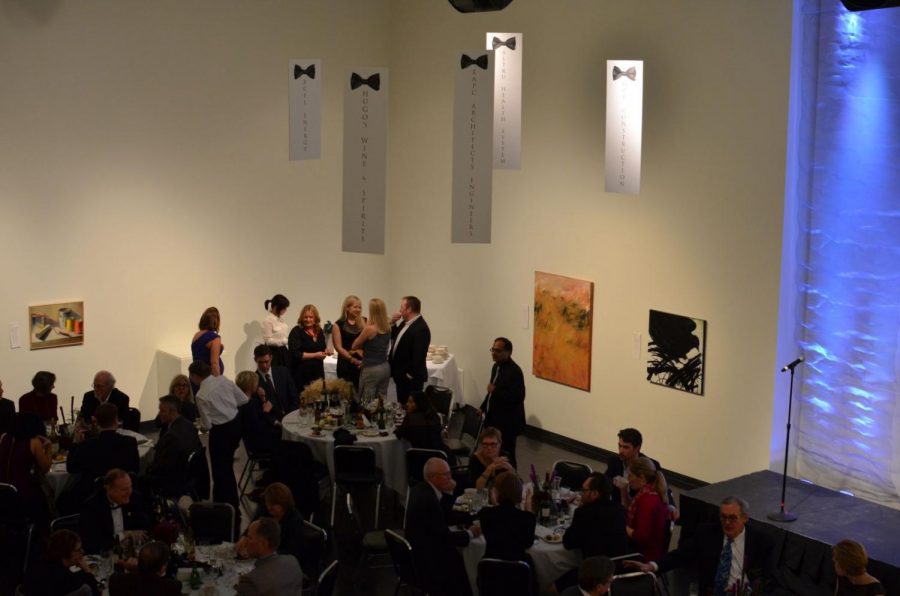- #dakotastudent
- Arts & Community
- Arts&Comm
- College
- Community Fun
- Dakota Student
- Grand Forks
- Maddie Deshler
- ND
- North Dakota
- Showcase
- Student Life
- UND
The North Dakota Museum of Art: A Hidden Gem
November 20, 2019
Upon entering the North Dakota Museum of Art, I am immediately embraced in bright light as I take in the very white walls of the museum. I climb up a few stairs and notice the familiar setup of the museum: the gift shop to my right, another set of stairs to my left, and a circular information desk directly in front of me. I immediately go to my left and ascend the stairs so I can get a view of the entire museum from the glass railings that overlooks the main level.
I take in all of the colors, shapes, and materials that surround me, and I am reminded of why I love art: because each and every piece of art is so unique, no matter how complex or simple the work is. Each artist has their own technique, their own skill, and most importantly, their own voice. It is through these pieces of art at the North Dakota Museum of Art that I can try to understand what it is that each artist is trying to say.
The North Dakota Museum of Art often goes unnoticed along Centennial Drive, especially since its brick structure causes it to blend in with the many other buildings on campus. The intricacy of the art that is displayed within the museum is emphasized by the two-story building’s simplicity though.
The current exhibits located on the main floor appear to be rather plain upon first glance. To the right you can find a collection of pottery and to the left you can see a line of banners hanging from the walls. However, the collection of pottery is so much more than a group of perfectly shaped bowls or vases and the banners are so much more than cloth resting on a wall.
The collection of ceramics, known as “Across Time,” was created by artist Robert Archambeau. A plaque next to Archambeau’s collection describes his passion for his work and even at the age of 91, he is still producing artwork. Archambeau sometimes produces 200 pots in the span of six weeks.
In one corner of the exhibit lies a grouping of stoneware whose colors remind me of those one can find in the sand on beaches: beige, cream, and light brown. Seated in another corner is a collection of burnt orange and chocolate brown pottery. These ones remind me of fall days, when the leaves drop from trees and rest along the sidewalks and streets around the city. Sketches of pots are encased in glass along the walls of the exhibit, emphasizing how each and every pot is so carefully shaped and designed that no two pieces are identical.
“I think there is something especially special about this kind of artwork. It seems so simple and easy to do, but realistically, it isn’t. I can’t even imagine how much creativity is put into each piece of pottery,” Halie Schmitt, a student of the University of North Dakota and a visitor at the museum, said.
Across the museum from this collection lays thirteen banners made by Vernal Bogren Swift. The banners are specifically called batiks. Batiks, by definition, are dyed cloth whose designs are created using wax to prevent certain parts of the cotton from being dyed. The backdrop of each batik in this collection is of a dark shade, such as black or brown, but the dyes to create the designs are contrastingly much lighter. Each exquisitely designed batik tells a story of some sort, with a focus on the existence of animals before humans came to be. It is for this reason that Swift is not only an artist, but she is also a storyteller.
Artwork can easily be mistaken as materialistic objects that, once completed, just sit on display somewhere, whether that be at a museum, store, or home. Although this may be true to some degree, pieces of art are never just objects. They represent diversity and uniqueness. They represent the gift and skill of artists. And most importantly, they act as a medium that artists, like Swift, can creatively share stories through. The North Dakota Museum of Art helps these stories get told, so make sure to take some time one day to go and explore these carefully crafted works of art.


